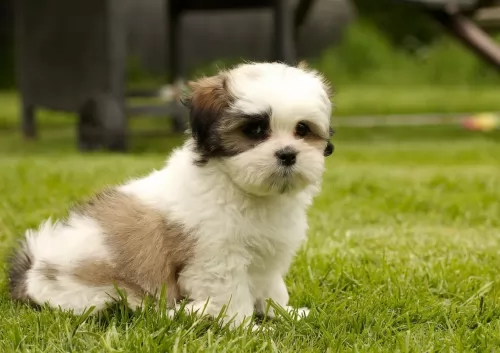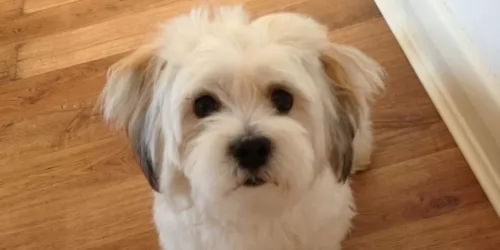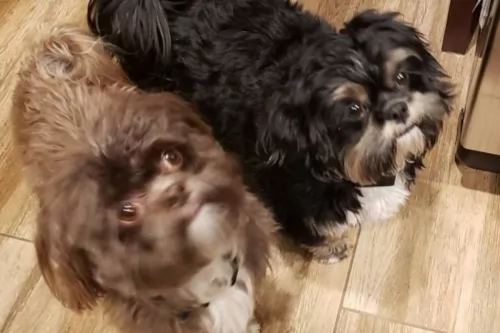 MyDogBreeds
MyDogBreedsRussian Harlequin Hound is originated from Russia but Kyi-Leo is originated from United States. Russian Harlequin Hound may grow 38 cm / 15 inches higher than Kyi-Leo. Russian Harlequin Hound may weigh 25 kg / 56 pounds more than Kyi-Leo. Russian Harlequin Hound may live 3 years less than Kyi-Leo. Both Russian Harlequin Hound and Kyi-Leo has same litter size. Russian Harlequin Hound requires Low maintenance. But Kyi-Leo requires Moderate maintenance
The origins of the Russian Harlequin Hound are somewhat vague as there are many Russian hunting hounds and many of them have a similar ancestry.
The Russian Harlequin Hound is an indigenous hound whose origins go back to the 18th century. The first breed standard was published in 1925.
The breed was then developed during the early 1900s – being a mix of Russian Hound and English Foxhound. The Russian Harlequin Hound is a rare dog breed and you will find it almost exclusively in Russia.
 The Kyi-Leo first came about in the 1950s in San Francisco, USA, with the crossing of two dog breeds – the Lhasa Apso and the Maltese.
The Kyi-Leo first came about in the 1950s in San Francisco, USA, with the crossing of two dog breeds – the Lhasa Apso and the Maltese.
Because this is a mixed-breed dog, it isn’t recognized by the American Kennel Club, but it is recognized by some of the other dog associations such as the American Rare Breed Association or ARBA as it is known. Today the dog is looked upon as a designer breed.
The Russian Harlequin Hound is a medium to large sized dog that stands between 55 – 68cm in height and weighs between 18 – 31kg.
He has a solid build with long, straight legs with a long tail that can be slightly curved. The head is broad and square with medium sized ears which are floppy. The short coat is essentially white with tri-colored markings of white, tan and black.
The Russian Harlequin Hound has an amicable expression to his face and is a friendly social dog breed. He is lively and energetic, and with his hunting background will required a good deal of exercise.
They make great family pets, getting on well with children in the home and making friends with any other pets in the family. He is a gentle dog and with training and socialization is well mannered and obedient.
He loves his human family and wants to spend time with them in their company. He isn't suited to life in the city and a small property, but will require a home with bigger grounds.
 The Kyi-Leo is a small dog standing at 20 – 30cm in height and weighing in the region of 4 – 6kg.
The Kyi-Leo is a small dog standing at 20 – 30cm in height and weighing in the region of 4 – 6kg.
He has a long, silky coat which is essentially black and white or grey/silver and white or even gold and white. He has frail legs which can become injured or broken in vigorous rough and tumble games.
You can certainly describe the Kyi-Leo as a sweet, quiet, non-aggessive playful dog, and for anyone who wants a splendid pet and companion, this dog makes a great family pet and he won’t cost you an arm and a leg to feed either.
He also has an acute sense of hearing and this turns him into an excellent ‘alarm’ watch-dog. It is also a dog, that while he will love to join you on a walk, he isn’t a dog that is going to demand a lot of exercise.
He responds well to his human family, is easy-going and gentle, tending to be cautious around strangers. You can trust him to be an awesome playmate for children. In this instance, it’s the children who should be warned when playing with a dog like this as, because of his fragile build, he could easily be injured by children who haven’t been taught to respect animals.
Even though he is such an amicable pet, it will still be of benefit to you and him to have him trained and socialized. Then he responds well to basic commands such as sit, stay and lie-down.
Dogs who spend time with their family, pick up on the ‘culture’ of the family and they learn how to behave. Dogs who are left on their own and never socialized can become nervous and aggressive towards people as they never got to learn how to behave – they weren’t socialized.
The Russian Harlequin Hound has always been a hunting dog, known for his excellent hunting skills. He isn’t only a good hunting dog, but he makes a good family pet too.
If you’re looking for an unusual dog breed that is also intelligent, loyal and loving, then you might want to consider this Russian Harlequin Hound.
 The Kyi-Leo is everything you want in a family companion – active, playful, loving, gentle, happy and balanced.
The Kyi-Leo is everything you want in a family companion – active, playful, loving, gentle, happy and balanced.
He loves his human family but tends to be a little bit wary around strangers, gradually warming to them.
He may be small, but he is robust and alert, and he is also capable of making you a good watchdog.
The Kyi-Leo is an all-round great little pet to have.
Your Russian Harlequin Hound is a rare dog breed that can reach 12 years of age if well cared for. There are some dog ailments that must be watched for. Cancer, ear infections and skin allergies can be problems to look out for. Other troublesome ailments can be -
This is a more common disease with deep-chested dogs, and the deep chested Russian Harlequin Hound is prone to bloat. Gas is trapped in the stomach and the stomach can actually twist. It can be life threatening. Your pet will have a hard, swollen belly and will be restless and salivating. Get him to the vet immediately. He may well require immediate surgery.
This condition is all about problems with the hip joints. It is sad for any dog with this disease as it can be painful for your pet to walk. Inflammation and arthritis can mean your pet being in pain. He can become lame too.
There are anti-inflammatory medications and your vet will suggest other treatments to make sure your pet is as comfortable as can be.
 Your Kyi-Leo is such a feisty, robust little dog who is not likely to cost you much in terms of health care. With his frail legs, it is a good thing to know that you need to be careful with him in terms of back-and joint problems.
Your Kyi-Leo is such a feisty, robust little dog who is not likely to cost you much in terms of health care. With his frail legs, it is a good thing to know that you need to be careful with him in terms of back-and joint problems.
There are actually knee joint issues which are fairly common in small dogs, one of which is patellar luxation.
This is where the kneecap pops out of the thighbone, causing the dog to skip or hop. Some joint issues are genetic and may require surgery. Make sure to keep your pet’s weight under control to remove additional stress on the joints.
This is another dog illness you want to be careful with. Acute pancreatitis -inflammation - is when the condition comes on suddenly while chronic pancreatitis is when pancreatitis occurs over a period of time.
With acute pancreatitis in dogs you’ll see symptoms such as vomiting, abdominal pain, tremors and reluctance to eat. Pancreatitis can be brought on by too much fat, especially rancid fat, some anti-biotics, a low protein diet or a sickness such as diabetes.
If you suspect pancreatitis in your dog, get him as quickly as possible to the vet.
The Russian Harlequin Hound needs both mental and physical stimulation. He is a curious dog and wants to be out and about sniffing around and exploring. He will need to have a walk every day as well as lots of ball- and rope games. He will suit being the pet of a busy, outdoorsy family as opposed to a family of couch potatoes.
The Russian Harlequin Hound is looked upon as a low maintenance dog breed, and with his short, dense coat you can get by with just brushing him twice a week. Because he is such a lover of the outdoors check him over for ticks and fleas when you brush him.
Check inside his ears for redness and infection.
Open his mouth and look for bad, rotting teeth.
Check him over for any unusual lumps.
Make sure his eyes are clear and free of discharge.
Trim his nails.
Every dog should be fed excellent food as this encourages good health. Commercially manufactured dog foods can be wonderfully convenient and nutritious if you get the better quality ones.
Try and include some simple, tasty home-made food to his diet . High-quality dry dog food will provide a balanced diet, but you want to make it a little more tasty for him by giving him some chopped up boiled chicken, brown rice, sweet potatoes, carrots and spinach. This can be added into the dry kibble twice a week.
Try and include some raw meat occasionally. Fresh, cool water should always be available around the clock.
 The Kyi-Leo doesn’t require vigorous exercising. One walk a day will keep them happy. There are pet owners who believe dogs can be permanently outside dogs where they can do their own exercise.
The Kyi-Leo doesn’t require vigorous exercising. One walk a day will keep them happy. There are pet owners who believe dogs can be permanently outside dogs where they can do their own exercise.
Everybody who knows dogs, knows they are social creatures who will simply lie at your backdoor just waiting for some response from their beloved human family. Every dog, regardless of breed or size, needs exercise and interaction with their humans every day.
Dogs left alone in the yard day after day are loney, frustrated and bored, and when they start digging or barking, irresponsible owners will ill treat them. These kind of people should never own a dog.
The Kyi-Leo has a sensitive stomach so he’ll need good quality food to avoid digestive problems. Ideally home-cooked food such as softly boiled chicken, brown rice and raw or cooked vegetables added into top quality kibble is the preferred diet.
Fresh, cool water needs to be constantly available.
Brush the long, silky coat at least twice a week to ensure it remains free of knotting. Brushing keeps the coat shiny too.
As a long eared dog, ears should be checked and cleaned regularly too. Air doesn’t reach the inside of their ears and the warm dampness in the ears are a breeding place for infection.
Nails should also be trimmed when they become long because left uncut they can hook onto things causing injury ad pain.
Small dogs are more prone to tartar formation and loss of teeth. You’ll notice that something isn’t right because your lively little dog will be lethargic, he may not want to eat his food and his face may be swollen. When you suspect dental problems, get him to the vet.